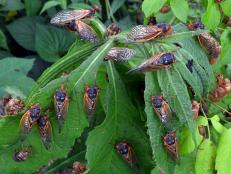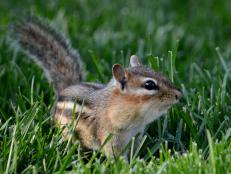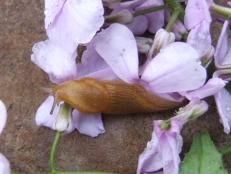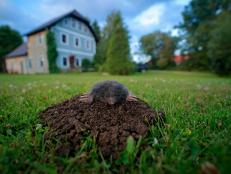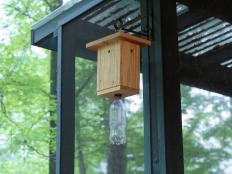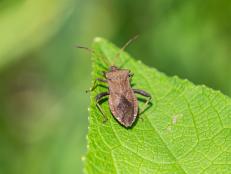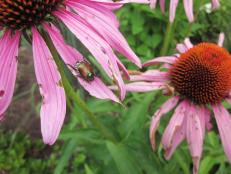Humane Ways to Get Rid of Groundhogs and Keep Them Away
Got groundhogs? Discover effective, all-natural ways to keep these critters out of your yard and garden.
Of all the wildlife that can visit your garden, one of the worst is a groundhog. Basically an overgrown squirrel, a groundhog has an appetite like Scooby and Shaggy: It never stops eating. In fact, the average groundhog can eat up to 1.5 pounds of vegetation every day. That’s an entire planting of beans, several rows of carrot tops and a whole trellis of peas. Turn one loose in an apple tree (yes, they can climb trees), and you won’t have any apples left to eat, let alone bake into pies.

Shutterstock/samray
Groundhogs tend to peek out of their burrows before leaving to feed. The burrow provides a place for a groundhog to raise its young and hide from danger.
What are Groundhogs?
Also known as a whistle pig or woodchuck, a groundhog is a type of marmot. That’s a mammal that spends spring and summer chowing down so it can survive winter hibernation. They’re usually brownish-gray, weigh 5 to 10 pounds, are 16 to 20 inches long and have a 4- to 7-inch dark, furry tail. With large front claws well suited for digging, groundhogs definitely have the necessary tools to excavate an extensive tunnel system.
Groundhogs dig burrows with tunnels that branch off to a den or living area, a latrine chamber and multiple exits. This is what makes groundhogs so tricky to get rid of. When they suspect danger, they retreat to their underground hideout. Typically, groundhogs venture only 50 to 100 feet from their den, so if you spot one, there’s a good chance it has a burrow nearby.
What do Groundhogs Eat?
Groundhogs are herbivores — they eat plants. Their favorites? Soybeans, clover, alfalfa, grass and the same tasty veggies you enjoy, including tomatoes, melons, cucumbers, zucchini and corn. Groundhogs live alone unless it’s a mother raising young, and all it takes is one of these critters to wipe out a typical vegetable garden.
Signs That You Have a Groundhog
Disappearing vegetables are usually the first clue that a groundhog has set up housekeeping in your yard. Typically, these mammals don’t just eat one cucumber or one lettuce plant — they gulp down several. Pay attention to what you have in your garden that’s ripening. Take photos to help you keep track. That way you’ll know if things are vanishing.
If you suspect there’s a groundhog lurking about, watch in the early morning (shortly after dawn) and evening. That’s when they’re most likely to be feeding. Sometimes they’ll sunbathe during the warmest parts of the day.
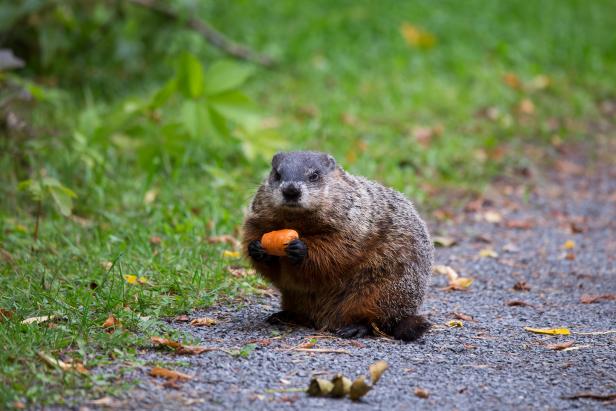
Shutterstock/Anne Richard
Groundhogs typically forage and feast during the early morning and evening. Some of their favorite foods include carrot, soybeans, peas, beans, alfalfa and clover.
When you spot a groundhog on your property, watch where it goes. If it’s gorging on your prize squash, head out quietly and make noise as you approach it. Watch where it runs for cover — it should lead you straight to its burrow entrance.
How to Identify a Groundhog Burrow
A groundhog burrow opening is 10 to 12 inches across. The active, main entrance has a mound of soil around it, which the groundhog constantly renews with fresh debris from the tunnels. Green horseflies usually buzz around an active burrow. The secondary entrances are typically just open holes without a large mound of soil.
Groundhogs dig their tunnels in hidden spots near an open, grassy area. In the wild, burrows are often in a small group of trees beside a field or in a hillside with thicker vegetation cover. In your yard, groundhogs are most likely to create a burrow along the edges of a shrub row or under a wood pile, deck or shed. They’ll also dig an entrance along a house wall or porch, especially an area where you don’t usually go.
Besides eating your garden, a groundhog’s digging can damage a home’s foundation, dislodge a retaining wall and create holes large enough for your mower to fall into. A common problem on farmsteads is livestock or people breaking their legs when they step into a groundhog hole.
How to Get Rid of Groundhogs
Having a groundhog target your garden as its daily buffet is a tough challenge, but there are ways to keep groundhogs at bay. Try some of these humane techniques to outsmart groundhogs.
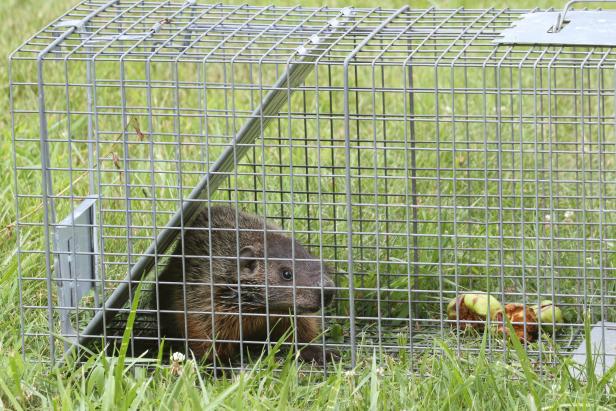
Shutterstock/Steve Byland
Before trapping groundhogs, check with your local extension office or Fish and Wildlife Service to learn your options for disposing of the critter. In some states, it’s illegal to release the animal anywhere but your own property.
- Keep things tidy. Groundhogs crave cover to hide their tunnel entrances. Remove any brush piles in your yard, trim around wood and compost piles, and weed beneath shrubs. Prune the lowest limbs on shrubs so there’s not a sheltered, hidden area. Maintain foundation plantings, trimming shrubs regularly and monitoring behind them.
- Pick regularly. Harvest your garden often, picking produce as soon as it’s ripe. Don’t let overripe produce remain on the ground to rot. Gather and dispose of it so the smell doesn’t attract critters.
- Try repellents. Groundhog repellents usually contain ingredients that smell bad or irritate a groundhog’s eyes or nose. Some are made from castor oil, red pepper or herb blends. Sprinkle granular repellents near a groundhog’s burrow and also around your garden to form a barrier, or spray them on plants to make them distasteful. Human hair, pet fur and used kitty litter may also work, along with electronic spikes that use sound or vibration and motion-activated sprinklers.
- Mimic predators. Coyotes and foxes are groundhog predators. Purchase predator urine and spray it around your yard and especially at the groundhog burrow entrance. Follow package instructions for re-application frequency.
- Frighten them. Groundhogs are skittish and skedaddle to the safety of their burrows at the slightest disturbance. Scare groundhogs by attaching mylar balloons around your yard and at the tunnel entrance. Brightly colored pinwheels, dangling CDs or shiny scare tape will also help keep groundhogs uneasy. Tie a beach ball to the end of a long string attached to a stake you place in your yard. As the wind blows, the ball will move, acting like a living scarecrow.
- Add a fence. The best method to keep groundhogs away is exclusion. For a fence to be effective, it needs to be heavy poultry wire or 2-inch woven-mesh wire and at least 3 feet high. Bury the bottom 12 inches in the ground, with the lowest 6 inches bent in an L-shape extending outward from the garden. This keeps the groundhog from digging under the fence. Bend the top 15 inches of the fence outward at a 45-degree angle. For extra insurance, add an electric wire 4 to 5 inches outside the fence and 4 to 5 inches off the ground.
- Use a trap. Groundhogs are pretty easy to trap, but if you don’t have a trap or are unsure what to do with the critter once you catch it, you might want to have an exterminator handle this part. Laws vary regarding what you’re allowed to do with a groundhog once you catch it. Research online or contact your local extension office or wildlife or conservation division to see what’s legal. If you decide to trap a groundhog, use fresh bait, replacing it frequently. Place the trap near the burrow entrance. Once you catch a groundhog, cover the trap with a thick towel or tarp and wear thick gloves to protect yourself when handling the trap.
What's the Difference Between a Groundhog and Gopher?
These two critters share several traits. Both love to eat plants and dig, and create mounds of soil at the entrance of their burrows. But that’s where the similarities end. A gopher has a hairless tail, protruding yellow or brownish teeth, pink feet and fur-lined cheek pockets for storing food. Groundhogs have a furry black tail, whitish teeth that aren’t visible unless the mouth is open, brown or black feet and no cheek pockets. Gophers tend to stay in their tunnels, eating plant roots and tubers, while groundhogs forage aboveground on leaves, fruits and vegetables.
Groundhog FAQs
Do groundhogs make a sound?
They make a high-pitched whistling noise to alert other groundhogs to danger. This sound is what earned them the nickname “whistle pig.”
Will a groundhog hurt my pets?
How to Keep Chipmunks Out of the Garden
Learn how to get rid of chipmunks in your garden and stop these critters from wrecking your yard.
Groundhogs dislike confrontation and typically run for cover if your pets are in the yard. Problems might occur, however, if your dog or cat is digging around a groundhog burrow entrance. A groundhog typically only bites if it feels cornered.
Is there anything a groundhog won’t eat?
In terms of vegetables, groundhogs tend to ignore onions, garlic, beets and potatoes. They also dislike many herbs, including lavender, lemon balm, fennel, chives, thyme and wormwood (Artemisia).
Are groundhogs dangerous?
In general, groundhogs only present a threat if they feel threatened. Although it rarely occurs, groundhogs can carry rabies, which means that if one bites a pet or family member, it may spread the disease.
30 Deer-Resistant Plants 31 Photos
Hungry deer tend not to bother these deer-resistant flowers and plants.










